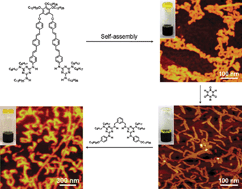A complementary guest induced morphology transition in a two-component multiple H-bonding self-assembly†
Abstract
An oligo(p-phenylenevinylene) (OPV) dimer, whose OPV units are capped on their end by monotopic melamine hydrogen-bonding units, self-assembles in


 Please wait while we load your content...
Please wait while we load your content...